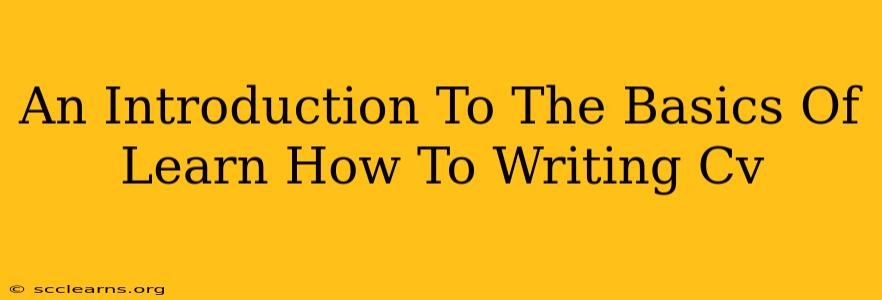Creating a compelling CV (Curriculum Vitae) is a crucial skill in today's competitive job market. A well-written CV acts as your first impression to potential employers, showcasing your skills and experience in a concise and effective manner. This introduction will guide you through the fundamental aspects of CV writing, helping you craft a document that grabs attention and secures interviews.
Understanding the Purpose of Your CV
Before diving into the specifics, it's vital to understand the purpose of your CV. It's not simply a list of your work history; it's a marketing document designed to highlight your qualifications and persuade employers that you're the ideal candidate for the job. Think of it as your personal brand statement – a snapshot of your career journey and potential.
Key Objectives of a Strong CV:
- Grab Attention: Your CV needs to stand out from the pile. A visually appealing format and compelling opening statement are crucial.
- Highlight Relevant Skills: Focus on the skills and experiences most pertinent to the jobs you're applying for. Tailor your CV to each application.
- Showcase Achievements: Don't just list your responsibilities; quantify your accomplishments whenever possible. Use numbers and data to demonstrate your impact.
- Demonstrate Value: Clearly articulate how your skills and experience can benefit the potential employer. What problems can you solve? What value can you add?
- Secure an Interview: The ultimate goal of your CV is to get you invited for an interview. Make it memorable and persuasive.
Essential Sections of a CV
While the specific sections might vary depending on your experience and the job you're applying for, some sections are almost universally included:
1. Contact Information:
- Full Name: Use a professional and easily readable font.
- Phone Number: Provide a reliable number where you can be easily reached.
- Email Address: Use a professional-sounding email address.
- LinkedIn Profile URL (Optional): Including a link to your LinkedIn profile can add credibility and allow recruiters to learn more about you.
- Location (Optional): You might choose to include your city and state, but avoid providing your full address for privacy reasons.
2. Summary/Objective Statement (Optional but Recommended):
A brief summary highlighting your key skills and career goals is highly beneficial, particularly for experienced professionals. For entry-level candidates, a concise objective statement outlining career aspirations can be more appropriate. Keep it concise – aim for 3-4 sentences maximum.
3. Skills Section:
This section lists both hard skills (technical abilities) and soft skills (interpersonal abilities). Categorize your skills logically for easy readability. Examples include:
- Hard Skills: Programming languages, data analysis software, specific software proficiency.
- Soft Skills: Communication, teamwork, problem-solving, leadership.
4. Work Experience:
This section forms the core of your CV. For each role, include:
- Job Title:
- Company Name:
- Dates of Employment:
- Responsibilities and Achievements: Use the STAR method (Situation, Task, Action, Result) to describe your accomplishments. Quantify your successes whenever possible.
5. Education:
List your educational qualifications, including degrees, certifications, and relevant coursework. Include:
- Degree Name:
- University/Institution Name:
- Graduation Date/Expected Graduation Date:
- GPA (Optional): Include if it's above average.
6. Awards and Recognition (Optional):
If you've received any awards or recognition related to your field, include them here.
Tips for Writing a Winning CV:
- Use a Professional Font: Stick to classic and easily readable fonts like Times New Roman, Arial, or Calibri.
- Keep it Concise: Aim for one to two pages, depending on your experience.
- Proofread Carefully: Errors in grammar and spelling can significantly hurt your chances.
- Tailor it to Each Job: Customize your CV to match the specific requirements and keywords of each job description.
- Use Action Verbs: Start your bullet points with strong action verbs to make your accomplishments stand out.
- Use Keywords: Incorporate relevant keywords from the job description to help your CV get noticed by Applicant Tracking Systems (ATS).
- Get Feedback: Ask a friend, mentor, or career counselor to review your CV before submitting it.
By following these guidelines, you can create a CV that effectively showcases your skills, experience, and potential, ultimately increasing your chances of landing your dream job. Remember, your CV is your first impression; make it count!

